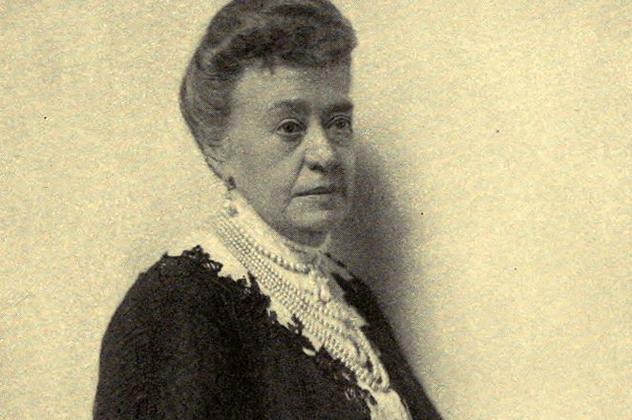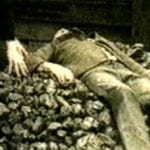 Humans
Humans  Humans
Humans  Animals
Animals 10 Species That Refused to Go Extinct
 Weird Stuff
Weird Stuff 10 Weird Things People Used to Do at New Year’s
 Our World
Our World 10 Archaeological Discoveries of 2025 That Refined History
 Weird Stuff
Weird Stuff 10 Fascinating Facts You Might Not Know About Snow
 Miscellaneous
Miscellaneous Top 10 Things Crypto Was Supposed to Change & What Actually Did
 History
History 10 Huge Historical Events That Happened on Christmas Eve
 Music
Music 10 Surprising Origin Stories of Your Favorite Holiday Songs
 History
History 10 Less Than Jolly Events That Occurred on December 25
 Weird Stuff
Weird Stuff 10 Funny Ways That Researchers Overthink Christmas
 Humans
Humans 10 Unsung Figures Behind Some of History’s Most Famous Journeys
 Animals
Animals 10 Species That Refused to Go Extinct
 Weird Stuff
Weird Stuff 10 Weird Things People Used to Do at New Year’s
Who's Behind Listverse?

Jamie Frater
Head Editor
Jamie founded Listverse due to an insatiable desire to share fascinating, obscure, and bizarre facts. He has been a guest speaker on numerous national radio and television stations and is a five time published author.
More About Us Our World
Our World 10 Archaeological Discoveries of 2025 That Refined History
 Weird Stuff
Weird Stuff 10 Fascinating Facts You Might Not Know About Snow
 Miscellaneous
Miscellaneous Top 10 Things Crypto Was Supposed to Change & What Actually Did
 History
History 10 Huge Historical Events That Happened on Christmas Eve
 Music
Music 10 Surprising Origin Stories of Your Favorite Holiday Songs
 History
History 10 Less Than Jolly Events That Occurred on December 25
 Weird Stuff
Weird Stuff 10 Funny Ways That Researchers Overthink Christmas
10 Murder Mysteries That Made History
Assassinations of presidents and kings aren’t the only killings that change our world. The victims in these 10 murders didn’t wield national power and most were quickly forgotten. Even so, their murders led to changes in the justice system, education, national affairs, society, and culture. Some of these cases were easy for authorities to solve; others remain a puzzle. All of them made history.
10A New York First

On the evening of December 22, 1799, Gulielma “Elma” Sands left her home in a Manhattan boarding house after confiding to her cousin that she was marrying her fellow boarder, Levi Weeks. She wasn’t seen again until January 2, 1800, when her body was discovered in the Manhattan Well.
Elma’s demise produced a list of “firsts” in US history. For starters, it was New York’s first scandalous murder mystery. According to their fellow boarders, Levi and Elma were lovers, which was quite shocking in 1799. Handbills and newspapers proclaimed that Levi had promised Elma marriage, then murdered her. Fascinated New Yorkers read that, on the night of the murder, residents heard Elma and Levi leaving the house at the same time. Only half an hour later, witnesses heard screams near the well. That was also the area where people claimed they’d seen a horse-drawn sleigh carrying two men and a woman. Both horse and sleigh resembled those owned by Levi’s brother, Ezra. By the time Levi went to trial on March 31, crowds were yelling, “Crucify him!”
Fortunately for Levi, his brother had something that still figures prominently in American justice: money. Ezra hired three famous defense attorneys, including two founding fathers: former Secretary of the Treasury Alexander Hamilton and future Vice President Aaron Burr. He also hired future Supreme Court Justice Harry Livingston. Over a century before the notorious trial of O.J. Simpson made the term famous, Levi was defended by the first legal “dream team.”
Levi’s savvy lawyers devised a strategy for creating reasonable doubt in jurors’ minds that’s still in use today. They presented alternative murder theories by casting suspicion on another boarder, Richard Croucher, and even plausibly demonstrated that Elma could have jumped into the well to commit suicide. They attacked Elma’s character by claiming that she’d slept with her married landlord, and they established alibis for Levi with their own witnesses while planting doubts about the prosecution’s witnesses.
In 1800, trials could run into the wee hours, and Levi’s sensational trial ended at 2:00 A.M. after two days of proceedings. A possibly tired and cranky judge announced that the prosecution hadn’t proved its case and made it clear that Levi should be declared “not guilty.” Within 10 minutes, the exhausted jurors complied. Somehow, the court clerk stayed awake to transcribe everything, making this America’s first recorded criminal trial.
Most New Yorkers remained convinced of Levi’s guilt (though some changed their minds months later when Richard Croucher was convicted of rape). Legend has it that Elma’s death affected American history in one last way: Elma’s angry cousin supposedly put a curse on Hamilton, who was shot to death in a famous duel. The disgraced shooter was Burr—whose life and career were never the same.
9The Lady And The Toxicologist

Marie Cappelle was an elegant, accomplished member of the French aristocracy. She was dismayed when her relatives made her marry Charles Lafarge who, it turned out, lived in a crumbling country chateau infested with rats.
While Charles was away on business, Marie sent him an affectionate letter and a homemade cake. Charles ate the cake, became violently ill, and died. Arsenic was found in Marie’s room, but she claimed that she’d only used it to kill those awful rodents.
In 1840, Marie went on trial for murder and arguments over her guilt or innocence spread through Europe and America. The prosecution brought in local chemists, who discovered arsenic in food which Marie had fed to Charles as well as arsenic in his stomach. Marie’s defense lawyer countered with a letter from France’s world-famous toxicologist Mathieu Orfila. A pioneer in the forensic study of poisons, Orfila complained that the prosecution had used outdated tests. He claimed that only the new test invented by British chemist James Marsh could reliably detect arsenic.
The court ordered the prosecution to perform the Marsh test. There was an uproar when the results showed no arsenic in Charles’ body. Marie’s supporters thought she’d go free, but instead the court had the Marsh test performed again—this time by Orfila himself. Though Orfila had first become involved in the trial on the side of the defense, he proclaimed that when he did the Marsh test (more correctly than the prosecution’s scientists), the results showed that Charles’s body contained arsenic after all.
For Marie, the trial meant a guilty verdict and a life sentence. For the public, it meant a new understanding that accurate forensics could determine guilt or innocence. Testimony from scientists became common in courts, as did the Marsh test. Arsenic had been given the nickname of “inheritor’s powder” because it was popular with those who wanted to kill a family member. It was easy to get arsenic as rat poison, and its deadly symptoms resembled those of natural illnesses. After the Lafarge trial, everyone knew that even tiny amounts of arsenic could be detected and used for proof of murder. Killers had to look for new ways to perform the perfect crime.
8Catch Me If You Can

If you love British detective stories, you owe a lot to a certain pair of pants. In 1842, a pair of trousers was shoplifted from a London pawnshop by Daniel Good, who soon had a constable hot on his trail.
The constable arrested Good in the stables where he lived as a coachman, then began a search for the stolen pants. Instead of the knickers, though, he found a scorched human torso without limbs or head under a pile of hay. That was when Good took off, locking the constable inside the stable. By the time the lawman contacted his superiors, Daniel Good was gone.
The torso belonged to Jane Jones. She was Good’s pregnant common-law wife whom he’d murdered so that he’d be free to pursue his newest love. The public was frightened that such a brutal killer was at large, and Scotland Yard dedicated nine divisions to tracking Good. In those pre-telephone days, officers of different divisions met to exchange clues on Good’s whereabouts. Unfortunately, that system was inefficient. Police could locate Good’s whereabouts, but never fast enough to catch him. Newspapers ran articles on Scotland Yard’s incompetence. Finally, someone recognized Daniel Good in Tonbridge—about 50 kilometers (30 mi) from London—and informed the Tonbridge police. Good was arrested, but the London Metropolitan Police and Scotland Yard got no credit.
Good was executed in May. By August, Scotland Yard had decided to improve efficiency at catching murderers like Good by setting up its first official detective force, which eventually became known as the Criminal Investigation Department (CID).
7Fingered For Murder

Thomas Farrow managed Chapman’s Oil and Colour paint shop in London. He and his wife, Ann, lived above the store until March 1905, when an errand boy discovered that Thomas had been clubbed to death. Ann lay unconscious and was unable to identify her attackers before she too died.
Scotland Yard determined that the killing had occurred earlier that morning and that the motive had been robbery. The store and apartment had been ransacked and an empty cashbox lay on the floor. Detective Inspector Charles Collins, head of the fingerprint division, examined the cashbox and found an unknown thumbprint that didn’t belong to police at the crime scene or the victims, nor to any criminals whose prints were on file.
Two brothers, Albert and Alfred Stratton, were soon taken in as suspects. The morning of the murder, a milkman saw two young men rushing from the paint store, and another witness claimed that she’d seen Alfred in the area at that time. When the brothers were fingerprinted, police found that a print from Alfred’s thumb matched the one on the cashbox.
Scotland Yard had pioneered the collection of fingerprints for identifying criminals, but so far they’d only used fingerprint evidence for one arrest: a bungling billiard ball burglar who was convicted of theft after he left his thumbprint on a newly painted windowsill. The police and prosecution worried that juries wouldn’t feel that mere fingerprints could be used to hang a murder suspect.
At the trial, Chief Inspector Collins gave the jury a lesson in identification through fingerprints. Using a blackboard and enlarged photos of the prints, he showed how the print on the cashbox and Alfred’s thumb print were identical in 11 crucial ways. He also explained how he worked with criminal prints for identification purposes. His presentation convinced the jury, who brought back a guilty verdict. Since Scotland Yard was so influential, Collins’s success opened the door for fingerprint evidence in courtrooms across the globe.
6A Murder Classic

Frankie and Johnny were lovers, Oh Lordy, how they could love.
[. . .]
Frankie threw back her kimono, she took out her forty-four,
Root-a-toot-toot three times she shot right through that hotel door.
She was after her man who was doing her wrong.
“Frankie and Johnny” is one of America’s most famous murder ballads. It’s been covered by hundreds of artists, including Leadbelly, Louis Armstrong, Mae West, Sam Cooke, Bob Dylan, Johnny Cash, and even Elvis. The song is based on the murder of the African-American ragtime composer Allen Britt, who was killed by his girlfriend Frankie Baker in 1899.
Frankie was a beautiful, successful prostitute who wore diamond earrings “as big as hen’s eggs.” Britt was her lover and pimp. The couple quarreled when Frankie discovered him with another woman. She begged him to come home with her, but he went to a party with his new girl instead. Britt came home late that night when Frankie was in bed. According to Frankie, they argued and, when her lover came at her with a knife to “cut her,” she grabbed her pistol from under her pillow and shot him.
At her trial, the jury agreed with Frankie’s need to defend herself. The judge even gave her back her gun. But many in her neighborhood felt that there were other answers to the mystery of what happened that night in her apartment.
Within days of the trial, a song called “Frankie Killed Albert” was composed by Bill Dooley. The song—which evolved into the popular ballad “Frankie and Johnny”—was enjoyed by just about everyone except Frankie. She hated the way people sang it when she went by. She hated the lyrics that proclaimed she’d killed Allen because he’d cheated on her, rather than because she’d had to defend herself. Some say that the song hounded her out of St. Louis. She eventually wound up in Oregon running a shoeshine parlor.
Even then, the popularity of Frankie’s story haunted her. It was the basis for the 1933 blockbuster film She Done Him Wrong, which jump-started the careers of Mae West and Cary Grant. Frankie angrily sued Paramount Studios, but she lost. She sued Hollywood again over the 1936 film Frankie & Johnny, but she lost again. Frankie died in 1952 before she could sue over Elvis Presley’s film Frankie and Johnny in 1966.
5The Secret Stanford Slaying

“This is a horrible death to die.” Those were the last words of Jane Stanford, who was poisoned in 1905. It was an unexpected end for the beloved co-founder of Stanford University. In 1891, Jane and husband Leland Stanford, a railroad baron and senator, created Stanford University as a memorial to their only son. Two years later, the senator died and Jane took over.
For years, Jane bankrolled Stanford and oversaw nearly every aspect of its management. In 1904, she was about to fire Stanford president David Starr Jordan, who wasn’t creating the school that Jane thought her husband had intended it to be. But around that time, Jane’s daily glass of mineral water tasted bitter. She spit it out and submitted the bottle of water for testing. The results showed that her drink had been laced with strychnine. Frightened and ill, Jane fled to sunny Hawaii with her trusted secretary, Bertha Berner. She seemed to be safe, but on February 28, 1905, she drank another tainted glass and, despite the best efforts of Hawaii’s doctors, died of strychnine poisoning.
If you never knew that the founding mother of Stanford was murdered, that’s because Stanford’s president wanted things that way. When Jordan arrived in Hawaii to return Jane’s body to California, he announced that the Hawaiian medical experts were all incompetent and Jane had actually died of natural causes. He even paid an inexperienced doctor who’d never examined Mrs. Stanford while alive to write a report that she’d died of heart failure. This explanation prevailed until 2003, when Stanford’s medical professor Dr. Robert Cutler published his investigative book The Mysterious Death of Jane Stanford, which used medical evidence to show that Jane had been poisoned.
So whodunit? Jane’s secretary was present at both poisonings but was said to lack a motive since she led a more comfortable life with her employer than without her. The person who had a motive was President Jordan (although it’s difficult to see how he could get poison into Mrs. Stanford’s mineral water). Jordan’s vision for Stanford had often been blocked by “an uncultured old woman,” as one member of the faculty called Jane. Instead of getting fired, Jordan stayed on as president and his vision for the college prevailed, with a strong emphasis on the sciences.
We’ll never know what Stanford—the university most closely connected to the inventive technology of Silicon Valley—would have been like today if Jane had remained in control, just like we’ll probably never know who killed her.
4The Mouse Trap

The world’s longest-running theatrical play is a murder mystery by Agatha Christie. The Mouse Trap has been running for over 60 years, and its plot is loosely based on a murder that shocked wartime Britain. In 1945, a doctor was called to a remote farm in Shropshire, England to examine a sick child. The doctor declared that the boy had been dead for hours, and a murder investigation began.
Reginald and Esther Gough were foster parents to both the dead 13-year-old Dennis O’Neill and his 11-year-old brother, Terence. Both brothers suffered from malnourishment that bordered on starvation, and both had ulcerated sores and scars that likely came from constant blows. When the coroner determined that Dennis had died from a beating, the Goughs were arrested.
At first, the Goughs’ story was that the boys’ injuries had come from fighting one another and that they were being treated for their ulcerated sores. But at the trial, Esther Gough admitted that Dennis was dead when she called the doctor and that she’d neglected the boys on her husband’s orders. He controlled the household, beating his wife and cruelly starving and beating the O’Neill boys nearly every night.
The jury was only able to give Esther six months for neglect because there was less proof against her. When Reginald was convicted of manslaughter, the public raised an outcry and an appeals court changed the verdict to murder. The public also called for reforms, since Reginald had a violent criminal record before the two boys were even put into his care. The failure to protect Dennis and Terence became a key to the mystery in Agatha Christie’s famous play. More importantly, it resulted in the Children Act of 1948, which established trained officers throughout Britain to ensure the healthy development of foster children and protect them from mistreatment.
3Three Strikes

Twelve-year-old Polly Klaas lived with her mother in Petaluma, a peaceful town in northern California that has been the location for nostalgic films like American Graffiti and Peggy Sue Got Married. On October 1, 1993, Polly and two friends were having a giggly slumber party when a burly man with a knife entered Polly’s bedroom and told the girls that he’d kill them if they screamed. He tied each girl up and left with Polly.
After the abduction, volunteers searched the Petaluma area in the hopes of finding Polly alive. Over two billion smiling images of the pretty seventh grader were distributed worldwide, and her abduction was featured on the TV show America’s Most Wanted. The media called Polly “America’s Child.”
On November 29, police arrested parolee Richard Allen Davis, who eventually confessed and revealed details that led to the discovery of the girl’s body on a hillside. Davis had been in and out of prison for nearly 20 years with a history of abducting and raping women. People magazine called him “a one-man crime wave.”
Publicity about Davis coincided with a petition drive led by Mike Reynolds. Reynolds’s daughter had also been murdered by a convicted felon, and he needed thousands of signatures to put an initiative on the ballot for a new law. Nicknamed “three strikes,” this law would mandate that anyone convicted of three felonies would automatically serve 25 years to life in prison.
Reynolds was nowhere close to the total signatures he needed to get the law on the ballot—until Davis’s arrest. After that, a San Francisco radio station launched a petition-signing drive and people lined up for blocks to participate. Polly’s murder also inspired California’s state legislature to pass a three-strikes law of their own, which went into effect in 1994. By 1999, 24 states as well as the federal government had some form of the three-strikes law on their books.
2An Independent Murder

In 1996, reporter Veronica “Ronnie” Guerin was sitting in her car in a Dublin traffic jam when two men on a motorcycle pulled up alongside her, shot her to death, and sped off. This gangland-style “hit” shocked Ireland, but no one was surprised that Guerin had been targeted.
Guerin was a crime reporter for Ireland’s Sunday Independent. Her column exposed the crimes of Dublin’s gangster kings and drug lords, and they’d attacked her before. Shots had been fired into her home and a stranger had once aimed a gun at her head before shooting her in the leg. Drug lord John Gilligan had punched her in the face and threatened her six-year-old son. But attempts at intimidation only angered Guerin, who’d continued to expose the stories that gangsters wanted hidden.
The investigation into Ronnie Guerin’s murder was the largest in Ireland’s history. Suspicion soon fell on John Gilligan because she’d pressed assault charges against him, and he’d told friends that he wasn’t going to let her put him in jail. The results of the investigation were far from perfect, but eventually Gilligan—along with most of the men who’d conspired to kill Ronnie—were in prison either for murder or for drug trafficking.
That wasn’t the only change her murder brought about. Because of Guerin, Parliament created the Criminal Assets Bureau (CAB) for confiscating any assets that were acquired through criminal activity. They also instituted a witness-protection program so that those who wanted to testify against mob bosses would no longer have to fear for their lives. Many career criminals fled Ireland. In 2013, the Sunday Independent wrote that CAB had cost Irish crooks 250 million euros. Other European countries adopted their own form of CAB, allowing even more criminals to pay the price for Guerin’s murder.
1Taking Down The Boss

Neil Heywood was a posh British expat in Beijing, China who ran a consulting company that helped British businesses expand into China. In November 2011, Heywood was found dead in Chongqing’s Lucky Holiday Hotel.
Chongqing’s highly respected police chief, Wang Lijun, investigated Heywood’s death. Wang was considered a “supercop”—under the orders of his boss, Chongqing Communist Party Secretary Bo Xilai, Wang had all but eliminated the gangsters who’d once controlled the city. Wang found no evidence of murder at the Lucky Holiday, and the police verdict was that Heywood had died of alcohol poisoning.
That should have been that. Instead, in 2012, Wang showed up at a US consulate in China, seeking asylum. He admitted that his boss’s wife, Gu Kailai, had murdered Neil Heywood. When he’d told Bo Xilai about the murder, Bo wanted it covered up. Their relationship had deteriorated to the point where Wang was afraid of his powerful boss. Bo Xilai’s anti-crime program, his attention to the needs of the poor, and his communist speeches made him a highly popular politician on track to become one of the country’s most powerful rulers.
Wang never received asylum, but after his murder accusations, Bo was removed him from power and Gu went on trial. She confessed that her friendship with Heywood (some said they were lovers) began in the 1990s when he’d helped her son get into Harrow, an aristocratic British school. Heywood also did business deals for Gu and Bo, and soon they owed him money. At her trial, Gu claimed that Heywood had threatened to harm her son unless he got paid, so she poisoned him.
Gu was convicted of Heywood’s murder, and Wang and Bo were convicted of covering it up. All are in prison. But questions remain about whether the mystery of Heywood’s murder has really been solved, or whether Bo’s political enemies used it to railroad the popular leader. Meanwhile, the murder spotlighted the corruption of China’s rulers along with their not-exactly-communist lifestyles of wealth, business influence, and fancy English schools for their kids. The scandal stirred public anger and unrest and ended the rise of Bo Xilai, China’s most powerful and charismatic liberal, keeping power in more conservative hands.
Sue Steiner is the author of Mom’s Bathtub Reader and the upcoming book Amazing Moms Who Changed The World. As a major contributing writer to over 20 books for Uncle John’s Bathroom Reader series, she’s learned a little bit about a lot. You can reach her at [email protected] or here.








